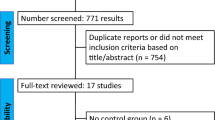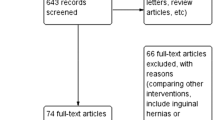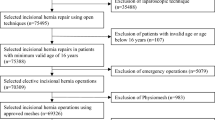Abstract
Purpose
There is debate regarding the use of drain tubes in incisional hernia repair. This has become topical in Australia, with a court judge suggesting that drain tubes are mandatory. There continues to be a lack of evidence to support generalised decision-making regarding the use of drain tubes.
Methods
The general surgeon membership of General Surgeons Australia (GSA) were surveyed regarding incisional hernia repair, their use of drains, and the decision-making behind their use.
Results
A total of 196 surgeons’ survey responses were analysed. Most surgeons perform less than 20 incisional hernia repairs per year (78%), prefer an open approach (78%), and preferably perform a pre-peritoneal (sub-lay) repair (53%). There was a variety of approaches to leaving a drain, with the most common answer being “sometimes” (31.28%) and an equal number of surgeons claiming to always or never leaving a drain (11.79% each). There was also no consensus in the duration the drain should stay in, with most surgeons averaging less than 5 days. Interestingly, there was a range of views on the effects of drain tubes, with some surgeons believing drains decreased infections and more believing they increased infections. Most surgeons felt seromas were decreased, but there was increased post-operative pain. The majority of surgeons agreed there was no evidence to support their beliefs.
Conclusion
Placement of drain tubes is not universally practiced by the general surgeons who participated in the survey. The lack of evidence is reflected by a varied approach to incisional hernia repair and the use of drain tubes.




Similar content being viewed by others
Abbreviations
- GSA:
-
General Surgeons Australia
References
Truskett P (2018) All ‘complex’ abdominal incisional hernia repairs using mesh must be drained: it’s the law. Aust N Z J Surg 88(1–2):5
Wysocki A, McGowan B (2018) To drain or not to drain: Supreme Court has the answer. Aust N Z J Surg 88(1–2):115
Holihan JL, Nguyen DH, Nguyen MT, Mo J, Kao LS, Liang MK (2016) Mesh location in open ventral hernia repair: a systematic review and network meta-analysis. World J Surg 40(1):89–99. https://doi.org/10.1007/s00268-015-3252-9
Deerenberg EB, Timmermans L, Hogerzeil DP, Slieker JC, Eilers PH, Jeekel J, Lange JF (2015) A systematic review of the surgical treatment of large incisional hernia. Hernia 19(1):89–101. https://doi.org/10.1007/s10029-014-1321-x
Tandon A, Pathak S, Lyons NJ, Nunes QM, Daniels IR, Smart NJ (2016) Meta-analysis of closure of the fascial defect during laparoscopic incisional and ventral hernia repair. Br J Surg 103(12):1598–1607. https://doi.org/10.1002/bjs.10268
Alam NN, Narang SK, Pathak S, Daniels IR, Smart NJ (2016) Methods of abdominal wall expansion for repair of incisional herniae: a systematic review. Hernia 20(2):191–199. https://doi.org/10.1007/s10029-016-1463-0
Cornette B, De Bacquer D, Berrevoet F (2018) Component separation technique for giant incisional hernia: a systematic review. Am J Surg 215(4):719–726. https://doi.org/10.1016/j.amjsurg.2017.07.032
Awaiz A, Rahman F, Hossain MB, Yunus RM, Khan S, Memon B, Memon MA (2015) Meta-analysis and systematic review of laparoscopic versus open mesh repair for elective incisional hernia. Hernia 19(3):449–463. https://doi.org/10.1007/s10029-015-1351-z
Al Chalabi H, Larkin J, Mehigan B, McCormick P (2015) A systematic review of laparoscopic versus open abdominal incisional hernia repair, with meta-analysis of randomized controlled trials. Int J Surg 20:65–74. https://doi.org/10.1016/j.ijsu.2015.05.050
Ventral Hernia Working G, Breuing K, Butler CE, Ferzoco S, Franz M, Hultman CS, Kilbridge JF, Rosen M, Silverman RP, Vargo D (2010) Incisional ventral hernias: review of the literature and recommendations regarding the grading and technique of repair. Surgery 148(3):544–558. https://doi.org/10.1016/j.surg.2010.01.008
Dietz UA, Fleischhacker A, Menzel S, Klinge U, Jurowich C, Haas K, Heuschmann P, Germer CT, Wiegering A (2017) Risk-adjusted procedure tailoring leads to uniformly low complication rates in ventral and incisional hernia repair: a propensity score analysis and internal validation of classification criteria. Hernia 21(4):569–582. https://doi.org/10.1007/s10029-017-1622-y
Massey LH, Pathak S, Bhargava A, Smart NJ, Daniels IR (2018) The use of adjuncts to reduce seroma in open incisional hernia repair: a systematic review. Hernia 22(2):273–283. https://doi.org/10.1007/s10029-017-1690-z
Kockerling F (2018) Onlay technique in incisional hernia repair-a systematic review. Front Surg 5:71. https://doi.org/10.3389/fsurg.2018.00071
Paasch C, Anders S, Strik MW (2018) Postoperative-treatment following open incisional hernia repair: a survey and a review of literature. Int J Surg 53:320–325. https://doi.org/10.1016/j.ijsu.2018.04.014
Durai R, Mownah A, Ng PC (2009) Use of drains in surgery: a review. J Perioper Pract 19(6):180–186. https://doi.org/10.1177/175045890901900603
Gurusamy KS, Allen VB, Samraj K (2012) Wound drains after incisional hernia repair. Cochrane Database Syst Rev. https://doi.org/10.1002/14651858.cd005570.pub3
Westphalen AP, Araujo AC, Zacharias P, Rodrigues ES, Fracaro GB, Lopes Filho Gde J (2015) Repair of large incisional hernias. To drain or not to drain. Randomized clinical trial. Acta Cir Bras 30(12):844–851. https://doi.org/10.1590/s0102-865020150120000009
Perkins SW, Williams JD, Macdonald K, Robinson EB (1997) Prevention of seromas and hematomas after face-lift surgery with the use of postoperative vacuum drains. Arch Otolaryngol 123(7):743–745. https://doi.org/10.1001/archotol.1997.01900070087014
Scevola S, Youssef A, Kroll SS, Langstein H (2002) Drains and seromas in TRAM flap breast reconstruction. Ann Plast Surg 48(5):511–514. https://doi.org/10.1097/00000637-200205000-00011
White TJ, Santos MC, Thompson JS (1998) Factors affecting wound complications in repair of ventral hernias. Am Surg 64(3):276–280
Pai D, Sharma A, Kanungo R, Jagdish S, Gupta A (1999) Role of abdominal drains in perforated duodenal ulcer patients: a prospective controlled study. Aust N Z J Surg 69(3):210–213. https://doi.org/10.1046/j.1440-1622.1999.01524.x
Shaha AR, Jaffe BM (1993) Selective use of drains in thyroid surgery. J Surg Oncol 52(4):241–243. https://doi.org/10.1002/jso.2930520409
Krpata DM, Prabhu AS, Carbonell AM, Haskins IN, Phillips S, Poulose BK, Rosen MJ (2017) Drain placement does not increase infectious complications after retromuscular ventral hernia repair with synthetic mesh: an AHSQC analysis. J Gastrointest Surg 21(12):2083–2089. https://doi.org/10.1007/s11605-017-3601-0
Pessaux P, Msika S, Atalla D, Hay JM, Flamant Y, French Association for Surgical R (2003) Risk factors for postoperative infectious complications in noncolorectal abdominal surgery: a multivariate analysis based on a prospective multicenter study of 4718 patients. Arch Surg 138(3):314–324. https://doi.org/10.1001/archsurg.138.3.314
Moro ML, Carrieri MP, Tozzi AE, Lana S, Greco D (1996) Risk factors for surgical wound infections in clean surgery: a multicenter study. Italian PRINOS Study Group. Ann Ital Chir 67(1):13–19
Weiss E, McClelland P, Krupp J, Karadsheh M, Brady MS (2019) Use of prolonged prophylactic antibiotics with closed suction drains in ventral abdominal hernia repair. Am Surg 85(4):403–408
Debry C, Renou G, Fingerhut A (1999) Drainage after thyroid surgery: a prospective randomized study. J Laryngol Otol 113(1):49–51. https://doi.org/10.1017/s0022215100143129
Mujagic E, Zeindler J, Coslovsky M, Hoffmann H, Soysal SD, Mechera R, von Strauss M, Delko T, Saxer F, Glaab R, Kraus R, Mueller A, Curti G, Gurke L, Jakob M, Marti WR, Weber WP (2019) The association of surgical drains with surgical site infections - a prospective observational study. Am J Surg 217(1):17–23. https://doi.org/10.1016/j.amjsurg.2018.06.015
Witzigmann H, Diener MK, Kienkotter S, Rossion I, Bruckner T, Barbel W, Pridohl O, Radulova-Mauersberger O, Lauer H, Knebel P, Ulrich A, Strobel O, Hackert T, Buchler MW (2016) No need for routine drainage after pancreatic head resection: the dual-center, randomized, controlled PANDRA Trial (ISRCTN04937707). Ann Surg 264(3):528–537. https://doi.org/10.1097/SLA.0000000000001859
Slater NJ, Montgomery A, Berrevoet F, Carbonell AM, Chang A, Franklin M, Kercher KW, Lammers BJ, Parra-Davilla E, Roll S, Towfigh S, van Geffen E, Conze J, van Goor H (2014) Criteria for definition of a complex abdominal wall hernia. Hernia 18(1):7–17. https://doi.org/10.1007/s10029-013-1168-6
Author information
Authors and Affiliations
Contributions
YL and RH conceived and designed the study. YL collected data. YL performed analysis. YL drafted the manuscript. RH provided senior supervision and contributed to the direction of the project. All authors edited the manuscript and approved the final version for submission.
Corresponding author
Ethics declarations
Conflict of interest
The authors declare that they have no conflict of interest.
Ethical approval
This study, where involving human participants was in accordance with the ethical and governance standards of the institutions involved. Ethical and governance approval number: ALR 07.2018.
Human and animal rights
This article only involves human participants and their rights have been observed through compliance with ethical standards as outlined.
Informed consent
Implied consent was used with an introductory paragraph heading the survey, including information on storage and publication of data. This was approved through the above ethical processes.
Additional information
Publisher's Note
Springer Nature remains neutral with regard to jurisdictional claims in published maps and institutional affiliations.
Electronic supplementary material
Below is the link to the electronic supplementary material.
Rights and permissions
About this article
Cite this article
Luo, Y., Mohammed Jinnaah, S., Masood, D. et al. Drain tube use in incisional hernia repair: a national survey. Hernia 25, 427–433 (2021). https://doi.org/10.1007/s10029-019-02115-3
Received:
Accepted:
Published:
Issue Date:
DOI: https://doi.org/10.1007/s10029-019-02115-3




